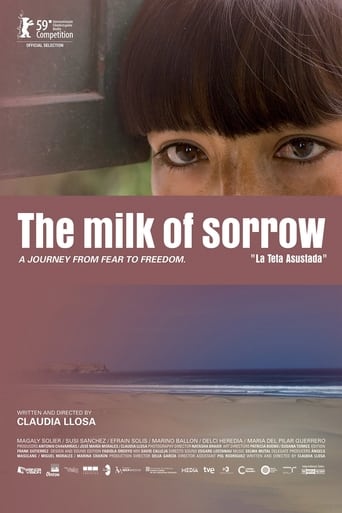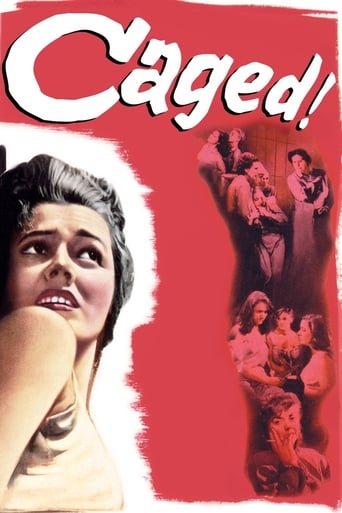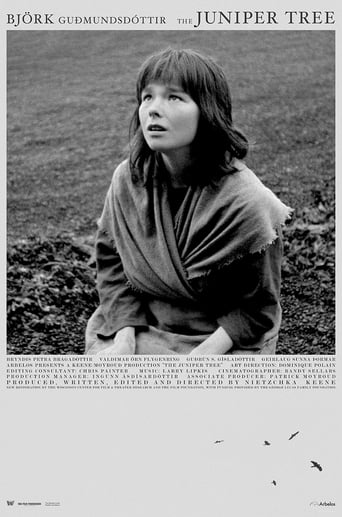The Milk of Sorrow (2010)
Fausta is suffering from a rare disease called the Milk of Sorrow, which is transmitted through the breast milk of pregnant women who were abused or raped during or soon after pregnancy. While living in constant fear and confusion due to this disease, she must face the sudden death of her mother. She chooses to take drastic measures to not follow in her mother's footsteps.
Watch Trailer
Free Trial Channels
Cast


Similar titles
Reviews
Some things I liked some I did not.
Did you people see the same film I saw?
The movie runs out of plot and jokes well before the end of a two-hour running time, long for a light comedy.
Strong acting helps the film overcome an uncertain premise and create characters that hold our attention absolutely.
La teta asustada is no action-packed thriller by any stretch of the imagination. But it is an emotional documentation of the saddening story of Fausta, an indigenous Peruvian woman who lives with her mother next to her aunt, uncle, and cousins.Throughout the movie, Fausta is subjected to a multitude of hardships, beginning with the death of her mother. The film begins with a somber song sung by Fausta mother that recounts her rape and contraception of Fausta during the time of terrorism in the hillcountry of Peru. Because Fausta's mother lived during this time, it was believed by the people in their village that Fausta was contaminated with the disease "la teta asustada," or "the milk of sorrow." The disease affected those who were nursed by women affected by the horrific events during that often-forgotten time in Peruvian history.While Fausta's believed diagnosis of "la teta asustada" is the cause for a lot discrimination against her, we also see the difference in rich and poor culture when she begins working for wealthy family in the city. Her relationship with the woman for whom she is working is strained and often times uncomfortable, but she finds solace in her relationship with the gardener. A speaker of her native Quechua, the gardener provides a needed sense of home in the bigger city, where she feels very out of place and at many times antagonized. This feeling ultimately culminates in Fausta's boss letting her go on the side of street after they attended a show in Lima where the woman performed one of Fausta's songs. We ultimately see many intersections of culture in Fausta throughout the movie. Almost all of which resulting in some form of criticism or hardship. This aggregation of misjustice is accentuated by the melancholy tone of the film, as well as the overall theme presented.
Fausta's aged mother passes away, singing a song that tells of horrific suffering in the not-so-distant past. That suffering has been passed on to her daughter through, according to local folklore, her mother's breast milk. With a potato inserted in her vagina, Fausta hopes to ward off the ugly indignities inflicted on her mother. Fausta's poverty, both material and spiritual, is thrown into sharp relief when she gets work as a housekeeper at the home of a wealthy and celebrated, but arid musician. The musician draws Fausta's song from her. And so, she begins to sing. This is a slow-burn film that offers startling images at time, and is strongest in its representation of the rituals of courtship, marriage and death. There is a rhythm and intensity to these scenes, a beguiling charm, that is disarming. Less successful are the long takes of Fausta (Magaly Solier) staring off into space when in the throes of her existential plight. The film goes after an imagistic rather than narrative experience and only partly succeeds. A dense film, in fact impenetrable at times, it offers strong symbolism, gritty ethnographic authenticity, but ultimately demands patience that it fails to completely reward, Magaly Solier's intensity failing to compensate for the plodding pace.
La teta asustada (or Milk of Sorrow) tells the story of Fausta, a young woman who suffers from the indigenous sickness of being condemned to live in fear forever. Terrorists raped her mother while she was pregnant and imparted her fear to Fausta through her breast milk. The strange awkwardness of the story is uncomfortable at times, but the audience slowly adjusts. This is the famous magical realism that Latin America is known for: the mixing of reality and fantasy in such a way that the impossible starts to seem more and more normal and possible. Having lived and studied in Lima for ten months, although it doesn't make me an expert, I found the film to be an accurate portrayal of life in the impoverished suburbs of the capital city. Mostly indigenous people fleeing from the mountains where terrorism was threatening them settled these dusty settlements on the outskirts of Lima in the 80s and 90s. In these communities indigenous traditions are still practiced and cherished to this day, but as portrayed in the movie there is also the clash of cultures as the people struggle to integrate into the life of the big city of Lima. I enjoyed this movie because it reminded me of all things Peruvian: the scenery, the struggles, the mix of indigenous and modern cultures and the ever important role of the potato.
Fausta, the young Peruvian of Indian extraction, is suffering from a strange malady. When taken to a clinic to be examined, the doctor examining her, determines she has a growth in her vagina, he compares it to having a potato growing up inside her. The uncle explains to the doctor it is a condition deemed to be 'the milk of sorrow', something that was passed from her mother as she breast-fed Fausta when she was an infant. Many women were violated by the rebel groups that preyed on the Indian communities. In order to prevent being violated Fausta is carrying a potato in her vagina, something the science man cannot begin to imagine.As the story begins, we see her with her mother who is singing a strange song, in Quechuan. Nothing seems to indicate she is suffering from an illness, but as the singing stops, the lady dies. Fausta is shocked when she realizes what has just happened. After accepting the fact about her mother, she must bury her. The uncle has already started to dig a spot in back of the house to serve as a tomb. Fausta does not have a lot of money. A visit to the undertakers prove to be useless, for she cannot afford to even buy the cheapest kind of funeral. In spite of that, Fausta and the women relatives, prepare the body by wrapping it in a sort of a shroud.With the problem still at hand, Fausta is engaged as a maid in the home of a lady pianist. Her instructions are not to let any strangers in the house. The place is adjacent to what seems to be a public market. Fausta, a shy woman is amazed by what she finds in the fancy home, but she never gets close to the lady of the house. The breaking of a string of pearls, brings the maid to help the lady, who promises to give Fausta the pearls, eventually. The only person that is closer to the girl is the gardener, a man that, at times ogles the young girl with more than necessary, but nothing happens between them.We witness a few garish weddings happening at the compound where Fausta's uncle lives. The family makes extra money by preparing these weddings, catering them, and providing entertainment. Sometimes Fausta helps serve the guests. After Fausta gets the pearls, her desire to bury the mother comes a possibility. We watch her and the relatives as they travel to a desert near the Pacific. Fausta knows exactly where will be her mother's resting place. The final shots of the film are full of symbolism. Fausta finds a small pot where two potatoes have flowered into a small plant.Claudia LLosa, the Peruvian creator of this film, sets her film among the poor classes in a Lima suburb populated by the destitute. The place is not a ghetto, by any means, the only thing in common with that, would be the poor housing where the people in the story live. The area is located in hills with steep stairs that are used by the locals to come to town. Fausta is a symbol of the oppressed classes by representing a small part of that culture. Ignorance and superstition are rampant among the population, where even a doctor is questioned when it is evident Fausta has something that will lead to a bigger problem if not treated properly.In Magaly Solier, Ms. LLosa has found a girl that personifies the type of individual she is supposed to be. Not having seen this actress before, or for that matter, any of the cast, seems to be a triumph for the director in getting the results she wanted to present. The character of Fausta is an enigma to most viewers. She is an aloof presence in the film. It is through her eyes the story is seen.Natasha Braier, the cinematographer captured the dreary locales in which the film is set with somber reverence. The music is by Selma Mutal, relying in the type of musical influence from the group at the center of the story. Ms. LLosa's film is highly feminine, showing an innate talent for great things to come.

















